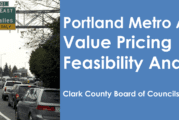 Oregon Department of Transportation spokesman Don Hamilton attempts to get tolling critics and Clark County citizens to see the other side of the issue
Oregon Department of Transportation spokesman Don Hamilton attempts to get tolling critics and Clark County citizens to see the other side of the issue
ClarkCountyToday.com Reporter Chris Brown stepped up and took a bullet for me this week.
I’ve owed a call back to Oregon Department of Transportation (ODOT) Public Information Officer Don Hamilton for a couple of weeks. Hamilton has actually reached out to me twice in recent months. The first time, we exchanged voice mails. The second time, I’m ashamed to say I didn’t return his call. That doesn’t reflect well on me.
Instead, Brown called Hamilton this week to give the ODOT spokesman an opportunity to share his recent thoughts on Oregon’s attempt to place tolls on I-5 and I-205. You can read Brown’s story that was generated from that interview here:
Final open house on Oregon’s tolling plan held in Vancouver

I don’t want to give you the wrong impression. Hamilton is good at what he does and he’s extremely cooperative and pleasant when he interacts with us on this topic. The fact that he is a former journalist also indicates we’re from the same corner of the jungle and I have a kinship for folks of that ilk.
Since my editorials have consistently been opposed to Oregon’s proposed tolling, Hamilton deserves credit for not only reaching out to me, but in doing so in such a professional spirit of cooperation. So, it’s not that I don’t want to communicate with him on this subject, it’s just that we see the issue so dramatically different that I’m not sure it’s a good use of each other’s time. I consider myself a pretty open-minded person, but I have to admit, on this issue I just can’t find anything in Hamilton’s comments in Brown’s story, or on other occasions, that causes me to reconsider my position.
First of all, there was a bit of good news offered by Hamilton in this story. Even if Oregon is successful in its attempt to place tolls on I-5 and I-205, it’s likely that the tolls won’t actually be initiated for “several years.’’ That’s about the only comfort I’ve received on this topic since Oregon lawmakers revealed their plans when they passed their $5.3 billion transportation package last year.
Oregon Department of Transportation Public Information Officer Don Hamilton shared his thoughts with ClarkCountyToday.com at a Value Pricing Open House held in January at the Vancouver Community Library. Video by Mike Schultz
Changing our behavior
In his interview with Brown, Hamilton reiterated that Oregon’s plan is to change the behavior of Clark County drivers. But, as I’ve said many times, we don’t want to change our behavior.
“I’ve been here for seven years now,” Hamilton said, “and the more time I spend here the more I realize that transportation isn’t about engineering, it’s about psychology. It’s really about human behavior.”
While money raised from tolling in Oregon would go to funding transportation projects, Hamilton says that’s not the ultimate goal. “The primary function here is to create more traffic at different times of day. An incentive that people will take the carpool, or a different time of day to travel,” he told Brown.
First of all, the I-5 corridor is so congested, I don’t believe a change in our behavior would have much of an impact. Anyone who travels in that corridor on a regular basis, can testify that the congestion issues are so significant that they aren’t limited to just peak times.
I live on the westside of Vancouver. Thankfully, I have no professional obligations that force me to travel the I-5 corridor between Oregon and Southwest Washington. But, I do travel to Oregon on a regular basis for social and entertainment reasons and I only do that during non-peak times and I regularly and consistently have to endure heavy congestion at seemingly all hours of the day, if not night.
For example, this past Sunday I was meeting friends for lunch at a restaurant in Jantzen Beach. I got over the I-5 bridge fine, but my two friends were coming from downtown Portland and Lake Oswego. Each of them were amazed that they had to sit in congested traffic in the northbound lanes of I-5 at 1 p.m. on a Sunday, with no apparent or obvious cause for the congestion. I have plenty of other examples that I have experienced at non-peak times but in the interest of brevity, I won’t detail them here.
But, the bottom line is we don’t want to change our behavior. We like our cars. The overwhelming majority of us are not going to get out of our cars to use rapid transit, or car pool with others, or adjust our lifestyles to travel during non-peak times, which I’ve expressed my doubt to the potential benefits of in the first place.
Benefits for Washington drivers
Another of my consistent arguments against Oregon’s tolling proposal is that the revenue generated would go to projects in that state’s $5.3 billion transportation package, which doesn’t include any projects that would provide for additional lane capacity or corridors.
I believe $430 million is targeted for improvements to the Rose Quarter area of I-5. While addressing that traffic bottleneck would certainly have benefits to Clark County commuters, the proposed improvements would not include any new lane capacity.so the impact on traffic congestion is going to be minimal.
I believe government at all levels collects enough of our earnings to provide ample tax revenue to fund infrastructure such as roads and bridges. But, I have to admit in the case of our traffic congestion issues on I-5 and I-205, if I were a decision maker sitting at the table, I might be able to swallow the concept of tolls in this instance if they went directly to building more lane capacity, bridges and another corridor or two.
Hamilton tried to convince us that Clark County drivers would get a benefit from the revenue generated by tolls.
“It hits everybody equally, and that means that you pay equally and you get the same benefits that everybody gets,’’ he said. “And I think that’s one of the things that gets lost in this, that there’s an advantage — there’s something you gain for the pay, and that is less congestion. And that saves you time.”
Without more lane capacity or another corridor or two across the Columbia River, I just don’t see how there will be less congestion, even if we’re willing to change our behavior. And, most of us are not.




 Oregon Department of Transportation spokesman Don Hamilton attempts to get tolling critics and Clark County citizens to see the other side of the issue
Oregon Department of Transportation spokesman Don Hamilton attempts to get tolling critics and Clark County citizens to see the other side of the issue